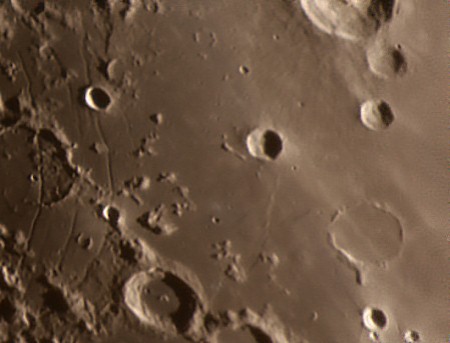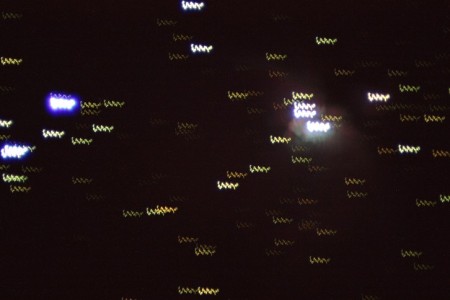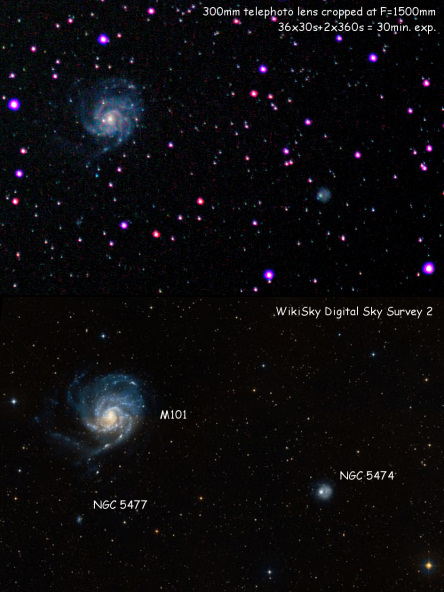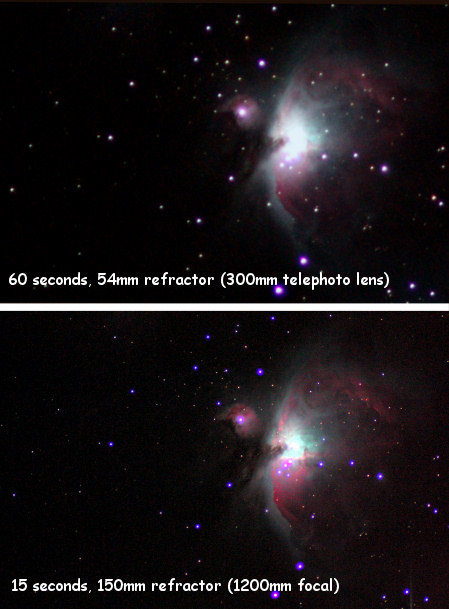Near Bullialdus crater (at top-right side of the picture) there is a quite interesting region called Rimae Hippalus. Hippalus crater is the big one (left-center side of the picture). It is a big crater. In this image, shadows in this crater due to a low altitude sunlight creates a visual effect, as if a great creature had stamped his bare footprint in lunar soil. Do you see it?
Archive for Reflex
Moon scratched by the claw of a bear
Posted in Astrophotography with tags Astronomy, Astrophotography, Bullialdus crater, Canon EOS 450D, Manual-Crazy-Tracking, Meade Lightbridge 16", Moon, Newtonian, no tracking, Reflex, Registax, Rimae Hippalus, Telescope on 2011/08/31 by computerphysicslabBright nebulae at Milky Way core
Posted in Astrophotography with tags Astronomy, Astrophotography, Canon EOS 450D, constellation, Deep sky, Fitswork4, Milky Way, nebula, Rebel XSi, Reflex, Sagittarius, Scorpius, Telescope on 2011/07/04 by computerphysicslabSummer views of Milky Way are spectacular because the galaxy bulge is brighter and broader than its spiral arms visible the rest of the year. Located near Sagittarius and Scorpius constellations, the bright nebulae and dark lanes of the area creates a beautiful contrast in brightness and colors.
This picture is a 4-pane mosaic ensambled with free software Fitswork 4.40. Every pane is a 10 minutes exposition through a 55mm lens attached to a Canon EOS 450d (Rebel XSi) DSLR camera, mounted over a motorized equatorial mount, Sky Watcher EQ6.
A full resolution picture is available at AweSky
EQ6 periodic error
Posted in Astrophotography with tags Astronomy, Astrophotography, Canon EOS 450D, Deep sky, DSLR, EQ6, guiding, mount, PEC, periodic error, Rebel XSi, Reflex, Sky Watcher, tracking on 2011/04/06 by computerphysicslabI took a bunch of 30 seconds shots aiming M42 nebula as regular, in order to stack them later. Polar alignment was also regular, using EQ6 polar scope, probably not perfect.
I think M42 is a good target to measure periodic error in RA movement due to its near 0 degrees declination.
In order to show the drift, I stacked the shots without drift correction using a free software called startrails that gets the brightest pixels per shot, obtaining that way the best startrail you can achieve.
To measure the length of the drift, I requested a single shot solved plate from astrometry.net. They provide an exact width in arcminutes of the field. Then, I divide the width field by the width in pixels of my DSLR camera sensor, obtaining the resolution per pixel in arcseconds (a number close to 1 arcsecond/pixel for a 1,200 mm effective focal length telescope).
Then I measure the height of RA drift pattern with my regular post-processing free software, Fitswork4, and multiply that value by the previous resolution.
That is the way I have found that my EQ6 mount drifts around 40 arcseconds in RA movement. Dividing total exposure by the number of cycles (top peak to lower peak) I got the elapsed time needed to fulfill the periodic error: around 6 minutes long.
Capella, the brightest star in Auriga
Posted in Astrophotography with tags Astronomy, Bright star, Canon EOS 450D, Deep sky, DeepSkyStacker, EQ6 equatorial mount, Rebel XSi, Reflex, Tamron SP-54B 300mm on 2010/10/02 by computerphysicslabCapella is the brightest star in Auriga constellation. It is very easy to spot in the Northern hemisphere. It is a circumpolar star, very bright one. The picture has been taken through a 300mm telephoto lens and Canon EOS 450d over a Sky Watcher EQ6 equatorial mount.

Here it is the full frame, with a lot of stars in the field and great detail:
http://www.awesky.com/Deep+Sky/Misc/Capella+-+Alpha+Aurigae/
M57, the Ring Nebula
Posted in Astrophotography with tags afocal, Astronomy, Canon EOS 450D, Deep sky, M57, Messier 57, NGC 6720, Planetary Nebula M57, Rebel XSi, Reflex, Ring Nebula, Telescope on 2010/09/21 by computerphysicslabThe Ring Nebula (also known as the Planetary Nebula M57, Messier 57, M57 or NGC 6720) is a prototypical planetary nebula in the constellation of Lyra. This is one of the most famous nebulae often used as an example of this type of astronomical objects. It is located at 0.7 kpc (2300 light years) from Earth and was discovered by Antoine Darquier de Pellepoix in 1779.
Their joint magnitude V-band (green filter) is equal to 8.80. Its real form is possibly a bipolar nebula seen with an inclination of 30 ° from its axis, and calculated that it has been expanding around 1600 years.
From their radial velocity, -19.2 km/s, it follows that approaches Earth more than 69120 km/h: this rate is caused by the combination of the sun’s orbital speed around the nucleus of the Milky Way and the speed of the Earth itself.
M57 is illuminated by a white dwarf at its center of visual magnitude 15.8.
This picture is a single shot of 30 seconds exposition through a SkyWatcher 6 inches refractor telescope at prime focus. Fitsworks4 was used to remove a bit the background noise.
M101 with 300mm telephoto lens
Posted in Astrophotography with tags Astronomy, Canon EOS 450D, Deep sky, DeepSkyStacker, EQ6 equatorial mount, M101, NGC 5474, NGC 5477, Rebel XTi, Reflex, Tamron 300mm, Ursa Major on 2010/04/25 by computerphysicslabThis is a crop of the resulting stacking of 36x30s + 2x360s subframes taken this month in two different sessions. The area showed corresponds to M101 and surroundings (in Ursa Major), in which we find other 2 galaxies NGC 5474 and NGC 5477. Below, I have added a DSS2 image of the are for comparison. My stars are blobs, meanwhile DSS2 are pinpoint. On the other hand, I use to lose star colours specially in the brightest ones , when postprocessing and stretching histogram. Maybe some day I will learn how to fix all these errors …
M31 – Andromeda Galaxy
Posted in Astrophotography with tags Andromeda, Astronomy, Canon EOS 450D, DeepSkyStacker, Galaxy, M31, m32, NGC 110, psp9, Rebel XTi, Reflex, Tamron 300mm telephoto on 2010/04/08 by computerphysicslabI took last winter 92 shots of 30 seconds to M31 using my 300mm telephoto lens. An EQ6 equatorial mount holded the Canon EOS 450d (Rebel XTi) camera. After stacking them with DeepSkyStacker and some post-processing with PSP9, here it is the result. The imaga shows M32 and NGC 110 too. I hope you enjoy it:
A 300mm telephoto vs a 6 inches refractor
Posted in Astrophotography with tags 6 inches refractor, Astronomy, Canon EOS 450D, EQ6 equatorial mount, M42, Rebel XTi, Reflex, Tamron SP-54B 300mm, Telescope on 2010/02/22 by computerphysicslabThe Tamron SP 54 is a 300mm telephoto lens, with an aperture of 54mm. I took a 60 seconds of exposition image of M42 in Orion. A few months later I took a 15 seconds image of the same field through a 6 inches Sky-Watcher non-apo refractor.
The comparison throws some interesting conclusions:
1.- A 150mm lens gives more resolution than a 54mm lens. Stars are fainter in the 6 inches refractor picture.
2.- The light captured by a 54mm lens in 60 seconds is nearly equivalent to the one captured by a 150mm lens in 15 seconds. Nebulosity appears practically equal in brightness in the two pictures. The lower image is a full frame, meanwhile the upper one is cropped at 25%.
Both images were taken using an unmodded Canon DSLR camera, EOS 450D (or Rebel XTi) and an EQ6 equatorial mount.
M31 from above
Posted in Astrophotography with tags Andromeda, Canon EOS 450D, Galaxy, M31, Perspective, Rebel XTi, Reflex, Tamron SP-54B 300mm, Telephoto on 2009/11/13 by computerphysicslabHere we see Andromeda galaxy as viewed from above. The spiral arms and structure becomes visible clearly in this processed image with a distortion nearly equivalent to a change of the observer location from our galaxy to a point in the void intergalactic space just above M31.
The original image from which this perspective has been obtained was a 4 minutes exposure with a 300mm telephoto lens and a DSLR Canon EOS 450d (Rebel XTi) camera.

Polaris A & Polaris B
Posted in Astrophotography with tags afocal, Astronomy, Canon EOS 450D, Deep sky, Newtonian, no tracking, Polaris, Polaris A, Polaris B, Rebel XTi, Reflex on 2009/10/18 by computerphysicslabPolaris has a close neighbor at 18 arcseconds that can be spotted easily through a telescope.

This is a 15 seconds exposure through a Meade Lightbridge 16-inch, a Dobson with no tracking, but fortunately Polaris moves very slowly through its small circumpolar path, due to its proximity to north pole in the sky. The camera used was a Canon EOS 450d, also known as Rebel XTi. The method employed was an eyepiece projection using a 14mm Meade Series 5000.
Auriga and Moonlight
Posted in Astrophotography with tags Astronomy, Auriga, Canon EOS 450D, constellation, Moon, no tracking, Rebel XTi, Reflex, shift-and-add on 2009/10/10 by computerphysicslabThis is a set of 71 single shots of 10 seconds each one to the Auriga constellation on 2009-10-08. The Moon was located at its south and its brightness is visible on the edge of the image and on the background gradient. The single frames were recorded using a Canon Rebel XTi (EOS 450d) and a conventional EF 18mm lens. The Kids is a triangle of stars on the upper side of Auriga constellation.

Tamron EOS Adaptor
Posted in Astrophotography with tags Adaptor, Astronomy, Canon EOS 450D, Pixco, Rebel XTi, Reflex, Tamron SP-54B 300mm on 2009/10/09 by computerphysicslabIn order to attach Tamron SP 54B 300mm telephoto lens to DSLR camera Canon EOS 450d (Rebel XTi) I used an adaptor found at ebay (Looking for “Tamron Adaptall 2 Lens To Canon EOS EF Mount Adaptor”). It works properly and it is very accurate when focusing to infinite. Pixco is the brand adaptor.

Tamron 300mm lens on Canon EOS
Posted in Astrophotography with tags Astronomy, Canon EF-S 18-55mm, Canon EOS 450D, Rebel XTi, Reflex, Tamron SP-54B 300mm on 2009/10/08 by computerphysicslabTamron SP-54B 300mm is a telephoto lens built 30 years ago, oriented to analog reflex camera market. Thanks to a special adapter for Canon EOS DSLR camera, I could attach them each other and take some shots. The field of view and the magnification are very different to a conventional lens, like Canon EF-S 18-55mm.
Here it is a comparison image:

Pitiscus
Posted in Astrophotography with tags 150/750, afocal, Astronomy, Canon EOS 450D, crater, Hommel, Ideler, Manual-Crazy-Tracking, Moon, Newtonian, Noiseware, Paint Shop Pro, Pitiscus, Rebel XTi, Reflector, Reflex, Registax, Spallanzani, Telescope, terminator on 2009/09/09 by computerphysicslabPitiscus, Hommel, Ideler and Spallanzani are the only four craters of the picture with proper name. The rest of them are named by letter surnames like Ideler R or Ideler L. They are located in the South-East area of the Moon. The picture was taken on 2009-09-09 05h 20m U.T. and the terminator was passing across Pitiscus, Hommel, the two big and shadowed craters. Pitiscus is 85 km wide and Hommel is 129 km (76 miles). The smallest craters of the image are 7 km wide, that is 3.5 arcseconds, 1.75 arcseconds for the bright spot and 1.75 arcseconds for the shadow spot. Image detail could then be better for a 6-inch telescope (this is the equipment used to take the image, an scope capable up to 0.7 arcseconds of resolution). 622 subframes were recorded with the Manual-Crazy-Tracking system and stacked in Registax 5.

Big Jupo
Posted in Astrophotography with tags 150/750, afocal, Astronomy, Canon EOS 450D, EOS Camera Movie Record, Jupiter, Mitchell, Newtonian, no tracking, Paint Shop Pro, Photoshop, Rebel XTi, Reflector, Reflex, resampling, shift-and-add, Telescope, VirtualDub on 2009/08/27 by computerphysicslabI have a good seeing last night. So I got my best Jupiter yet. Here it is:

It is 4x resampled via Registax Mitchell and PS. After resampled I can spot more details in bands and polar zones.
As always I used the 6-inch no-EQ mounted newtonian reflector, the 14mm eyepiece doing afocal projection over the Canon EOS 450d (Rebel XTi) body and recording video using “EOS Camera Movie Record” free software. Three times Jupiter crossed over the field of view. Registax and VirtualDub added and stacked the footage properly.
Jupiter Opposition
Posted in Astrophotography with tags 150/750, afocal, Canon EOS 450D, Jupiter, Newtonian, no tracking, Opposition, Paint Shop Pro, Photoshop, Rebel XTi, Reflector, Reflex, shift-and-add, Telescope on 2009/08/17 by computerphysicslab15th August 2009 was the day that Jupiter reached its closest position to Earth. Its apparent diameter was 49 arcseconds, so this is the best time to do planetary astrophotography with the giant planet. Using the afocal technique and a Canon EOS 450d body I took 2 video sequences and processed with Registax 5, Photoshop & Pain Shop Pro.
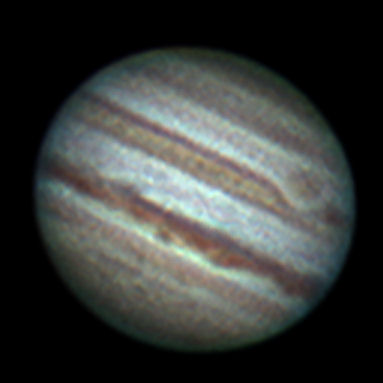
Mare Crisium & Tranquillitatis
Posted in Astrophotography with tags 150/750, afocal, Astronomy, Canon EOS 450D, Lu, Mare Crisium, Mare Tranquillitatis, Moon, Newtonian, no tracking, Paint Shop Pro, Proclus, Rebel XTi, Reflex, Registax, shift-and-add, Telescope on 2009/08/08 by computerphysicslabTwo days after full moon Mare Crisium shows a nice landscape of mountains and shadows. Some of its inner crates are visible in this picture. The small crater Swift is on the limit of visibility. The big impact called Proclus and its rays are remarkable.
To take this image I used the Canon EOS 450d, Rebel XTI DSLR camera recording video subframes and later I stacked them up with Registax 5. Some small tweaks on Paint Shop Pro 9 and ready.
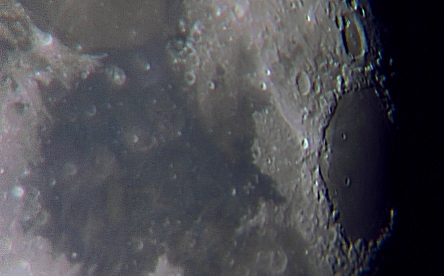
Full Moon
Posted in Astrophotography with tags 150/750, Astronomy, Canon EOS 450D, Canon EOS Rebel XTi, Full Moon, Newtonian, no tracking, Reflex, Registax, saturation, shift-and-add, Telescope on 2009/08/06 by computerphysicslabIn order to catch the Moon, I took 4 single shots at prime focus through my 150/600 telescope. As I lack of a T-mount adapter I had to take them in handheld mode. After de-rotating them accordingly, I stacked them up with Registax 5 and removed the noise a little bit. I used the body camera Canon EOS 450d (Rebel XTi) at high resolution, low sensitivity (ISO 100) and high shutter speed 1/2000. This is the result after a blow up in saturation:

DSLR to a LightBridge
Posted in Astrophotography with tags Canon EOS 450D, Canon EOS Rebel XTi, Meade Lightbridge 16", prime focus, Reflex, Telescope on 2009/05/18 by computerphysicslabSomeone asked: “Has anyone had difficulty focusing a DSLR to a LightBridge? I bought the appropriate adapters but cannot focus on any subject. It would seem that the LightBridge focuser extends too far away from the secondary. It seems the obvious answer is to install a focuser with less length. ”
Yesterday I was also trying to focus my DSLR Canon EOS Rebel XTi (EOS 450d) through my Meade Lightbridge 16″, but it was not possible. I haven’t still bought any T-adapter, because I was not sure it could reach the focus. Indeed it doesn’t reach it even without any adapter.
Maybe changing the focuser to a zero profile one could work. Or maybe not.
There is a trick to find out where the focal plane is exactly. When seeing the Moon, remove any eyepiece from the focuser and project the light into a cardboard perpendicular to the focuser axis. When the Moon gets clear and focused, there it is exactly located the focal plane at prime focus.
Knowing the distance from the CCD camera to the T-adapter it is possible to find out if a low profile focuser could reach the focus for prime focus astrophotography.
Hyakutake under several filters
Posted in Astrophotography with tags C/1996 B2, Hyakutake, Praktica, Reflex on 1996/04/29 by computerphysicslabThe Great Comet of 1996, Hyakutake, was bright in the night sky. Here we see one shot with Praktica Reflex camera and low magnification lens, under heavy image process. Several filters were applied.

C/1996 B2 on Praktica Reflex
Posted in Astrophotography with tags C/1996 B2, Hyakutake, Praktica, Reflex on 1996/04/03 by computerphysicslabA long exposure under dark skies got Comet Hyakutake. I was need to apply some enhancement image processing techniques to increase contrast.

Hyakutake C/1996 B2
Posted in Astrophotography with tags C/1996 B2, Hyakutake, Praktica, Reflex, Tamron 300mm telephoto on 1996/03/29 by computerphysicslabHyakutake comet, also know as C/1996 B2, is passing near the Earth at March 1996. This photo was taken with Praktica Reflex camera and Tamron 300mm telephoto lens.

Comet Szczepanski C/1996 B1
Posted in Astrophotography with tags 50mm, alfa Leo Major, C/1996 B1, Comet, Manaluna Observatory, Reflex, Regulus, Szczepanski on 1996/03/17 by computerphysicslabComet Szczepanski C/1996 B1 captured with a 50 mm Reflex analog camera under dark skies, Manaluna Observatory. Comet Szczepanski was very dim, around 8th magnitude, near Regulus, alfa Leo Major.

